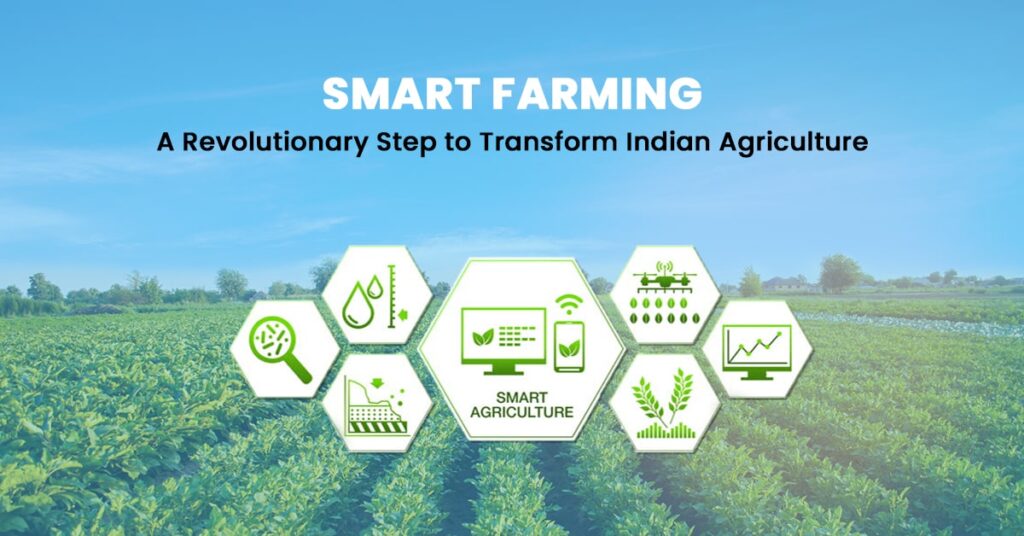
-
Phone:
+91 934 567 891 -
For Investments:
investment@farmmyland.in -
For Partnerships:
partnerships@farmmyland.in

Agriculture is the backbone of India, contributing nearly 18% to the country’s GDP and employing over 50% of the population. However, the traditional methods of farming are facing major challenges, including climate change, soil degradation, water scarcity, and declining productivity.
To overcome these challenges, farmers and agricultural entrepreneurs are turning to Smart Agriculture, a revolutionary approach that integrates technology, data, and automation to maximize efficiency, reduce waste, and boost yields.
In this blog, we will explore the future of farming, the latest advancements in Smart Agriculture, and how initiatives like Farm My Land are adopting modern techniques to ensure sustainable and profitable farming.
Smart Agriculture, also known as Precision Farming, is the use of advanced technologies like Artificial Intelligence (AI), Internet of Things (IoT), Robotics, Drones, and Data Analytics to improve farming efficiency. Unlike traditional farming, which relies heavily on human labor and guesswork, Smart Agriculture enables data-driven decision-making, optimizing every aspect of the farming process.
Key components of Smart Agriculture include:
With erratic rainfall and extreme weather patterns becoming more common, farmers can no longer rely on traditional weather cycles. Smart Agriculture helps predict weather changes and ensures water-efficient farming through automated irrigation.
As India’s population continues to grow, food demand is expected to rise significantly. Smart Agriculture ensures higher yields with minimal resource wastage, making farming more sustainable.
The agricultural labor force in India is shrinking due to urban migration. Automation and AI-powered solutions help bridge the gap by reducing the need for excessive human labor.
Many farmers suffer from low profits due to unpredictable crop yields and price fluctuations. With data-driven insights, farmers can grow high-demand crops, optimize input costs, and increase profitability.
By minimizing excessive pesticide use, improving soil health, and using water efficiently, Smart Agriculture promotes environmentally friendly farming while maintaining high production levels.
The future of Indian farming is being shaped by cutting-edge technologies. Here are some of the most promising advancements:
IoT-based smart sensors are transforming Indian farms by tracking:
These real-time insights help farmers make data-backed decisions, reducing costs and increasing efficiency.
AI-driven models analyze historical weather patterns, soil conditions, and crop performance to provide:
With urbanization reducing available farmland, hydroponic and vertical farming techniques allow for high-yield crop production without soil, using nutrient-rich water solutions. Farm My Land is exploring these innovative farming methods to maximize land use efficiency.
Despite its benefits, adopting Smart Agriculture comes with challenges:
To overcome these barriers, initiatives like Farm My Land are working on making Smart Agriculture more accessible, affordable, and farmer-friendly.
At Farm My Land, we believe that technology-driven farming is the future of Indian agriculture. Our approach includes:
Our mission is to bridge the gap between traditional agriculture and modern technology, ensuring that farmers achieve higher profits while preserving natural resources.
The future of farming is not just about growing more food—it’s about growing food smarter. Smart Agriculture is revolutionizing Indian agriculture by making farming more efficient, sustainable, and profitable. While challenges exist, technology is rapidly transforming how food is grown, and initiatives like Farm My Land are leading the way in bringing these innovations to Indian farmers.
If India wants to feed its growing population, combat climate change, and empower its farmers, Smart Agriculture is no longer an option—it is a necessity.
Stay ahead of the agricultural revolution with Farm My Land—where technology meets tradition for a sustainable and food-secure India.